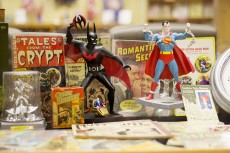By Hieu Truong/ reporter
Graphic novels are beautiful arts of literature, the SE library services director told students Oct. 27.
Jo Klemm discussed the importance of using graphic novels in the classroom, beginning with a definition.

Anthony White/The Collegian
“What is a graphic novel?” she asked. “A story or concept told or explained using pieces of art placed in sequence.”
Klemm said she was not always a fan of graphic novels. She thought of them as comic books but learned to appreciate the value of graphic novels.
Graphic novels are helpful tools in the classroom, Klemm said. They are generally dark and intense stories, she said. They are not always funny and not always easy to read.
Klemm said cartoons and graphic novels are not the same. A cartoon generally is a strip, and one gets the whole thing in one single read whereas graphic novels are multiple pages. Comic books and graphic novels are distinct as well. Comic books are periodicals while graphic novels are long fictional stories, she said.
Graphic novels can be about philosophers, theory, financial management or history, or they can be a graphic depiction that explains a mathematical concept. The industry calls all of those graphic novels, Klemm said. If someone is using graphic novels in class, most likely it is not a novel, Klemm said. Generally, novels are stories made up with literature.
“We live in an age of visual bombardment,” she said. “Part of what we do in college is to teach students to interpret the visual, not just the written work.”
Graphic novels are helpful to English language learners, Klemm said. The pictures can give clues that help interpret the words. Graphic novels can present a difficult issue in a way to make it easier to discuss. Some students have a hard time understanding stories like “Beowulf” or something by Shakespeare. Graphic novels give students the visual aid to understand the story, she said.
Researchers have found graphic novels helpful for students with autism, who have a hard time picking up social cues, verbal tone and inflection, Klemm said. Graphic novels give students with autism extra visual clues. For example, facial expression in the graphic novels and letters in bold print help people with autism understand the emotion that’s being conveyed in the piece of literature, she said.
“Schools teach art and how it is important to society,” she said. “Schools also teach literature as part of what humans can do.”
Schools today teach appreciation of literature and art together. Graphic novels follow the same literal construct that the classic literature does, Klemm said. They have a traditional hero and the quest followed by the same problem, climax and solution.
“We need to teach and appreciate in different ways that we can,” Klemm said.
With a new library focus, one of the librarians decided to order graphic novels, so SE Campus now has a collection of them.
Klemm encouraged students to check out the library’s exhibit case with liberal arts divisional dean Jerry Coats’ antique comic books.

